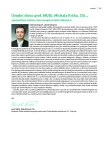Thyroid disease in the Czech Republic: the EUthyroid project and the evaluation of the General Health Insurance Company epidemiological data for the period of 2012–2015
Authors:
Radovan Bílek 1; Lenka Horáková 2; Robert Goš 2; Václav Zamrazil 1,3
Authors‘ workplace:
Endokrinologický ústav, Praha
1; Ústředí Všeobecné zdravotní pojišťovny, Praha
2; Subkatedra endokrinologie IPVZ, Praha
3
Published in:
Vnitř Lék 2017; 63(9): 548-554
Category:
Original Contributions
Overview
Institute of Endocrinology participates in the grant of European Commission EUthyroid (Towards the elimination of iodine deficiency and preventable thyroid-related diseases in Europe), together with other 28 European countries. The role of Institute of Endocrinology in EUthyroid is among other things to ensure access to national registers relating to thyroid diseases. The results presented here correspond to the years 2012–2015 and are based on data from the General Health Insurance Company Czech Republic (VZP CR), which has 6 million insured persons (ratio male : female = 1 : 1). The set is sufficiently representative to be related to the whole of the Czech Republic. According to VZP data, the prevalence of thyreopathies is constantly increasing, for example according to the code of diagnoses E00–E07 and the unique birth number, the prevalence of thyreopathies increased from 6.8 % in 2012 to 7.5 % in 2015. The increase of the prevalence is mainly concentrated to clinical manifestation of hypothyroidism (code E03, an increase from 2.8 % in 2012 to 3.2 % in 2015); the second is nontoxic struma (code E04), which had a constant prevalence of 2.5 % in the given period. On the other hand, thyroiditis (code E06), the third in the order of occurrence, increased from 1.8 % in 2012 to 2 % in 2015. The decrease in prevalence only occurred in hyperthyroidism (E05) from 0.7 % in 2012 to 0.6 % in 2015. Other thyreopathies had a prevalence of less than 1 %, and was constant between 2012 and 2015 (other thyroid disorders E07 0.8 %, thyroid disorders associated with iodine deficiency E01 0.2 %, E02 0.07 %, E00 0.01 %, thyroid carcinoma C73 0.13 %).
Key words:
EUthyroid – General Health Insurance Company – occurrence of thyreopathies – thyroid disease in the Czech Republic
Sources
1. [WHO, UNICEF, ICCIDD]. Assessment of iodine deficiency disorders and monitoring their elimination: a guide for programme managers. 3rd ed. WHO: Geneva 2007. ISBN 978 92 4 159582 7. Dostupné z WWW: <http://apps.who.int/iris/bitstream/10665/43781/1/9789241595827_eng.pdf>.
2. Bílek R, Kaňová N, Mindžáková V et al. Zásobení jódem u těhotných žen v České republice. Vnitř Lék 2016; 62(Suppl 3): 3S10–3S16.
3. Zamrazil V, Bílek R, Čerovská J et al. The elimination of iodine deficiency in the Czech Republic: the steps toward success. Thyroid 2004; 14(1): 49–56.
4. Bílek R, Bednář J, Zamrazil V. Spectrophotometric determination of urinary iodine by the Sandell-Kolthoff reaction subsequent to dry alkaline ashing. Results from the Czech Republic in the period 1994–2002. Clin Chem Lab Med 2005; 43(6): 573–580.
5. WHO, UNICEF. Iodine status worlwide. In: de Benoist B, Andersson M, Egli I (eds) et al. WHO Global Database on Iodine Deficiency. WHO Department of Nutrition for Health and Development: Geneva 2004. ISBN 92 4 159200 1. Dostupné z WWW: <http://apps.who.int/iris/bitstream/10665/43010/1/9241592001.pdf>
6. Ryšavá L, Kříž J. Řešení jodového deficitu v České republice – historie a současný stav. Vnitř Lék 2016; 62(Suppl 3): 3S103–3S106.
7. Ryšavá L, Kříž J, Kašparová L et al. Zásobení jodem a jodurie obyvatel v České republice v letech 1995–2016. Vnitř Lék 2016; 62(Suppl 3): 3S28–3S32.
8. Lazarus JH. Iodine status in Europe in 2014. Eur Thyroid J 2014; 3(1): 3–6. Dostupné z DOI: <http://dx.doi.org/10.1159/000358873>.
9. WHO. Iodine deficiency in Europe. A continuing public health problem. Andersson M, de Benoist B, Darnton-Hill I (eds) et al. WHO Press: Geneva 2007. ISBN 9789241593960. Dostupné z WWW: <http://www.who.int/iris/handle/10665/43398>.
10. Lynn R, Vanhanen T IQ and the wealth of nations. Praeger 2002. ISBN 978–0275975104.
11. Bergman A, Heindel JJ, Jobling S (eds) et al. [United Nations Environment Programme (UNEPP) and the World Health Organization (WHO)]. State of the science of endocrine disrupting chemicals 2012. WHO Press: Geneva 2013. ISBN 978 92 4 150503 1.
12. McGrogan A, Seaman HE, Wright JW et al. The incidence of autoimmune thyroid disease: a systematic review of the literature. Clin Endocrinol (Oxf) 2008; 69(5): 687–696. Dostupné z DOI: <http://dx.doi.org/10.1111/j.1365–2265.2008.03338.x>.
13. Cramer JD, Fu P, Harth KC et al. Analysis of the rising incidence of thyroid cancer using the Surveillance, Epidemiology and End Results national cancer data registry. Surgery 2010; 148(6): 1147–1152. Dostupné z DOI: <http://dx.doi.org/10.1016/j.surg.2010.10.016>.
14. Giusti F, Falchetti A, Franceschelli F et al. Thyroid cancer: current molecular perspectives. J Oncol 2010; 2010 : 351679. Dostupné z DOI: <http://dx.doi.org/10.1155/2010/351679>.
15. Klecha AJ, Barreiro AML, Frick L et al. Immune-endocrine interactions in autoimmune thyroid diseases. Neuroimmunomodulation 2008; 15(1): 68–75. Dostupné z DOI: <http://dx.doi.org/10.1159/000135626>.
16. Guarneri F, Benvenga S. Environmental factors and genetic background that interact to cause autoimmune thyroid disease. Curr Opin Endocrinol Diabetes Obes 2007; 14(5): 398–409.
17. Langer P, Kocan A Tajtáková M et al. Increased thyroid volume, prevalence of thyroid antibodies and impaired fasting glucose in young adults from organochlorine cocktail polluted area: outcome of transgenerational transmission? Chemosphere 2008; 73(7): 1145–1150. Dostupné z DOI: <http://dx.doi.org/10.1016/j.chemosphere.2008.06.067>.
18. Zimmermann MB. The Influence of Iron Status on Iodine Utilization and Thyroid Function. Annu Rev Nutr 2006; 26 : 367–389.
19. Kralik A, Eder K, Kirchgessner M. Influence of zinc and selenium deficiency on parameters relating to thyroid hormone metabolism. Horm Metab Res 1996; 28(5): 223–226.
20. Crofton KM. Thyroid disrupting chemicals: mechanisms and mixtures. J Androl 2008; 31(2): 209–223. Dostupné z DOI: <http://dx.doi.org/10.1111/j.1365–2605.2007.00857.x>.
21. Urbansky ET. Perchlorate as an environmental contaminant. Environ Sci Pollut Res Int 2002; 9(3): 187–192.
Labels
Diabetology Endocrinology Internal medicineArticle was published in
Internal Medicine

2017 Issue 9
Most read in this issue
- Adenosine – a mediator with multisystemic effects (or a hormone?)
- Anabolic steroid induced hypogonadism in men: overview and case report
- Thyroid carcinomas: the present view on diagnostics and therapy
- Primary hyperparathyroidism – new clinical forms of the disease
